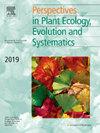Urban green spaces as reservoirs of exotic plant species with invasion risk: A case study on the ornamental flora of Nairobi City, Kenya
IF 2.9
3区 环境科学与生态学
Q1 ECOLOGY
Perspectives in Plant Ecology Evolution and Systematics
Pub Date : 2025-03-12
DOI:10.1016/j.ppees.2025.125864
引用次数: 0
Abstract
Human-driven global redistribution of flora for various economic purposes has contributed to the naturalization of several thousand species of plants outside their native ranges. A significant proportion of naturalized species have become invasive whereby they significantly alter biodiversity, disrupt ecosystems, and cause socioeconomic losses. Urban ornamental horticulture is a major pathway for the introduction of exotic plants, as these species are widely cultivated for their aesthetic appeal and adaptability. However, inventories of exotic plants grown in urban areas are lacking in many African countries. This study surveyed ornamental plants in 100 urban green spaces (parks, gardens, urban forests, cemeteries, playgrounds and squares) in Nairobi City, Kenya. The objective was to assess the prevalence of exotic species, their geographic origins, economic uses, and naturalization/invasion status. We identified 638 plant species, 11 of which are native to Kenya. Trees were the most common, followed by shrubs and perennial herbs. Most exotic species originated from Africa, South America, and tropical Asia, while fewer came from North America, Europe, and Oceania. Of the exotic species, 53 % were casual (not yet established in the wild), 30 % were invasive somewhere in the world and 17 % were naturalized. In addition to their ornamental use, all species served various purposes: medicinal (48.43 %), construction (29.31 %), environmental conservation (17.40 %), human food (2.98 %), multiple uses (0.94 %), fodder (0.63 %), and biofuels (0.31 %). The finding that 30 % of exotic ornamental plant species grown in Nairobi City had a history of being invasive in different parts of the world emphasizes the need for proactive measures to prevent their potential invasion in Kenya and other regions with similar climates.
城市绿地作为具有入侵风险的外来植物的储存库——以肯尼亚内罗毕市观赏植物为例
由于各种经济目的,人类驱动的全球植物区系再分配已经促成了数千种植物在其原生范围之外的归化。相当大比例的归化物种已成为入侵物种,从而显著改变生物多样性,破坏生态系统并造成社会经济损失。城市观赏园艺是引进外来植物的主要途径,因为这些物种因其审美吸引力和适应性而被广泛种植。然而,许多非洲国家缺乏在城市地区种植的外来植物库存。本研究调查了肯尼亚内罗毕市100个城市绿地(公园、花园、城市森林、墓地、操场和广场)中的观赏植物。目的是评估外来物种的流行程度、地理来源、经济用途和归化/入侵状况。我们确定了638种植物,其中11种原产于肯尼亚。树木是最常见的,其次是灌木和多年生草本植物。大多数外来物种起源于非洲、南美洲和热带亚洲,而少数来自北美、欧洲和大洋洲。外来种中,53 %为偶然种(尚未在野外建立),30 %为世界某处入侵种,17 %为归化种。除了观赏用途外,所有物种还具有各种用途:药用(48.43 %)、建筑(29.31 %)、环境保护(17.40 %)、人类食品(2.98 %)、多种用途(0.94 %)、饲料(0.63 %)和生物燃料(0.31 %)。在内罗毕市种植的外来观赏植物中,有30% %在世界不同地区具有入侵历史,这一发现强调了采取积极措施防止它们在肯尼亚和其他类似气候地区的潜在入侵的必要性。
本文章由计算机程序翻译,如有差异,请以英文原文为准。
求助全文
约1分钟内获得全文
求助全文
来源期刊
CiteScore
6.50
自引率
0.00%
发文量
28
审稿时长
67 days
期刊介绍:
Perspectives in Plant Ecology, Evolution and Systematics (PPEES) publishes outstanding and thought-provoking articles of general interest to an international readership in the fields of plant ecology, evolution and systematics. Of particular interest are longer, in-depth articles that provide a broad understanding of key topics in the field. There are six issues per year.
The following types of article will be considered:
Full length reviews
Essay reviews
Longer research articles
Meta-analyses
Foundational methodological or empirical papers from large consortia or long-term ecological research sites (LTER).

 求助内容:
求助内容: 应助结果提醒方式:
应助结果提醒方式:


